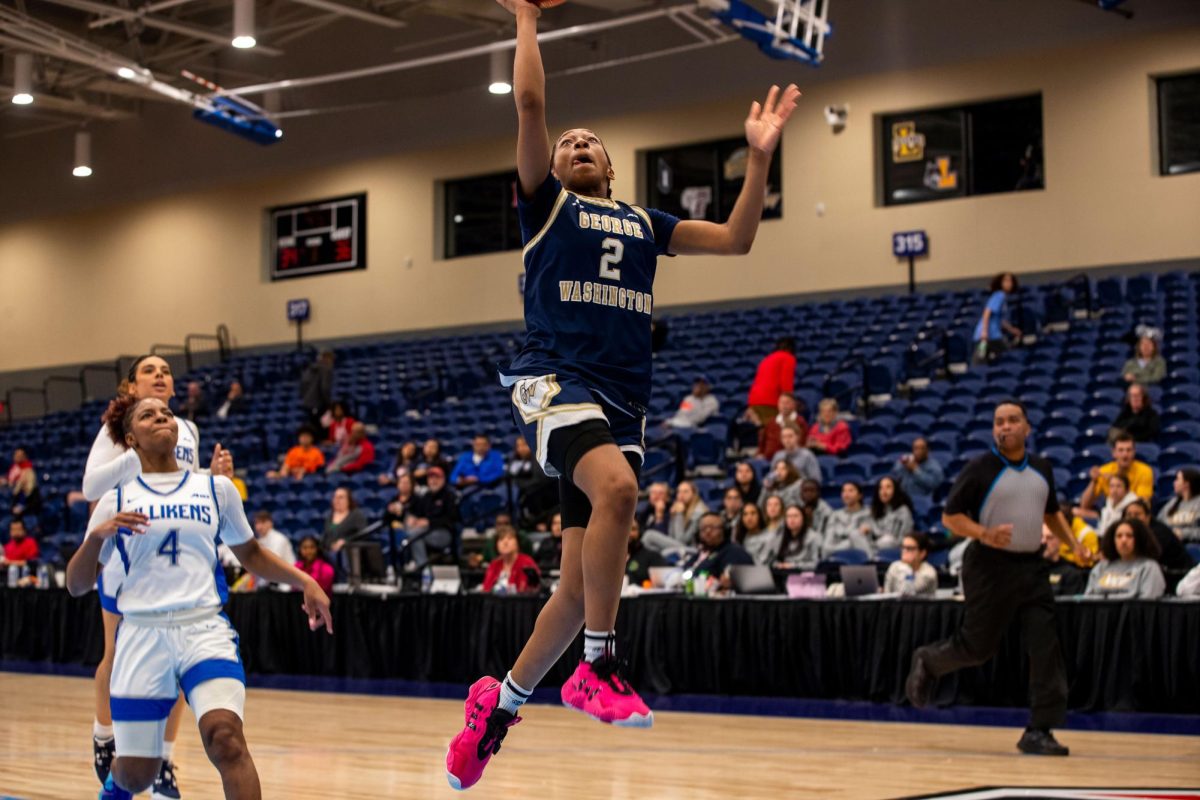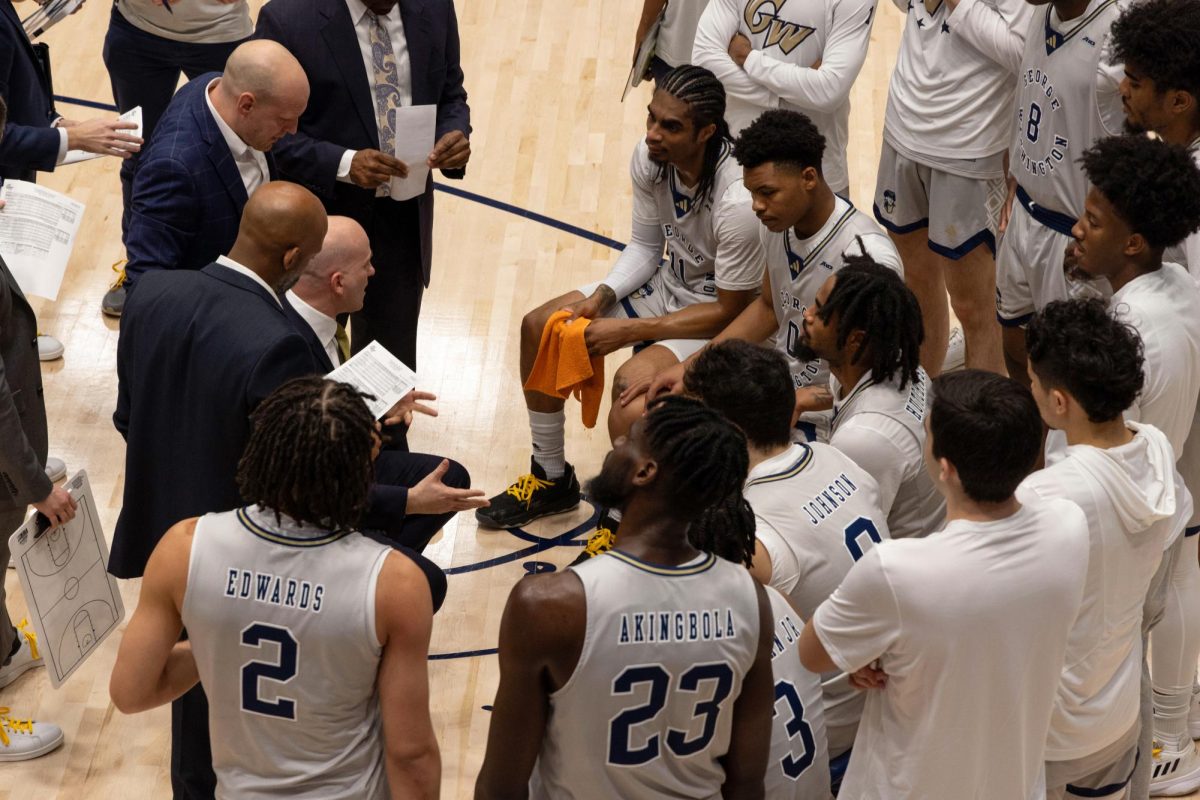Going into this year, the oft-said phrase for GW basketball fans was “special season.” But that was for the men’s team. Women’s head coach Joe McKeown was skeptical after losing star Anna Monta?ana, and with No. 1 Tennessee and No. 11 Purdue on the schedule, the early part of the season was going to be rocky.
Fast-forward a few months.
The men’s team is 13-1 and 3-0 in the Atlantic 10 while the women are 11-4 and 4-0 in the A-10 with such records, GW has joined the likes of Duke and Boston College as one of nine schools in the nation with two teams in the top 25 of college basketball.
The Atlantic Coast Conference has four in Maryland, Duke, North Carolina and Boston College. Ohio State and Michigan State represent the Big 10 while Oklahoma is the Big 12’s sole representative. Connecticut, which plays in the Big East, rounds out the nine.
GW and the Atlantic 10 seldom see two teams from the same school in the top 25. The last time it happened in Foggy Bottom was Jan. 4, 1994.
Despite the luster that comes with placement in The Associated Press and ESPN/USA Today polls, the honor is somewhat misleading. GW Director of Athletics Jack Kvancz acknowledges that the votes are gotten through performance and relationships.
“On the men’s side between Dom and myself, I don’t even want to think about how many coaches we speak to in the course of a week,” Kvancz said, referring to Dom Perno, GW’s assistant director of athletic development and the former head coach at Connecticut. “You think we’ll say ‘we stink, we’re terrible?’ we’ll say ‘man, we’re pretty good.’ If that’s lobbying, then yeah, you do that.”
With McKeown, it’s a bit easier to gain admission into the top 25.
“On the other side its pretty different,” Kvancz said. “He’s been around a long time and he knows people. He gets the respect.”
Perno said that GW has respect as a program.
“If you look at both teams, every year they know GW will be at a certain level,” Perno said. “The game with Maryland gives us a lot of respectability. You can still lobby, but those wins really promote in the minds of the general public. For us to do that, is great.” The Colonials defeated Maryland for the second straight year on Dec. 5.
Perno conceded that the men have a different level of respect.
“On the men’s side, you really have to get in. You’re not just getting in,” he said. “We had some good wins last year. We had people who have never given money in the past give money in the last week. The overall interest is so much better.”
“We’ve had people calling about Charlotte tickets. Normally, we get three people. That’s what you get when you’re in the top 25. Everybody feels a part of it now. As an athletic department, the top 25 is what you shoot for,” Perno said.
Perno and Kvancz said schools with major football programs have an easier time gaining admission into the rankings.
“If we are playing ping-pong against Notre Dame, people will say ‘that must be a good game,'” Kvancz said. “If you play a football school in soccer, people think it must be a good game. I think a lot of the people who make the polls think that.”
As a university and athletic department, GW vastly differs from the other schools in this exclusive group of universities with two teams in the top 25. Along with Duke and Boston College, GW is the only other private institution. State schools such as Maryland and Ohio State, universities whose states take much pride in their teams, have a far easier time recruiting players from in state. The GW Athletic Department cannot rely on recruiting top recruits due to lack of prominence and somewhat lackluster facilities.
In addition to recruiting prowess, GW is the third-smallest school in terms of undergraduate population on the list of (6,107 undergraduate population) and Boston College (9,059), have fewer undergraduate students but both play in arenas bigger than the 5,000-seat Smith Center.
The most distinguishing difference between the Colonials’ athletic program and the other schools in the group of nine is NCAA tournament success. Every school except for GW and Boston College has been in the national championship game at least once. Between men’s and women’s teams North Carolina has won five championships, Duke has taken three and Connecticut has won seven. GW women went to the Elite Eight in 1999 while the men have gone as far as the Sweet 16 in 1993.
But as the University reaps the benefits from the success, it is largely misleading. The polls are voted on by two factions in the basketball community: The Associated Press releases the writers’ poll while coaches vote in the ESPN and USA Today poll. On the men’s side, the only voting coaches that GW faces in the regular season are Phil Martelli of Saint Joseph’s and Gary Williams of Maryland. On the women’s side, McKeown has been far more successful and thus other coaches know to look to Foggy Bottom for success. The Philadelphia Inquirer’s Mel Greenberg, who created The Associated Press women’s poll, sees GW play on a regular basis.
“I’ll tell you what, we haven’t had this many stories written about us ever,” Kvancz said.
Financially, the implications are still unknown.
“What I can tell you is that people are talking about us,” Kvancz said. “We’ve gotten more stories in the last two weeks than we’ve ever gotten. Those are the types of things that I can tell you right now. I can tell you there’s more interest and people are coming. I can’t tell you the bottom line yet. Will it be better than last year? I think so.”
And to the skeptics who think GW is not at that level yet, Kvancz has a simple thought.
“All I say to them is ‘play me here’.”







